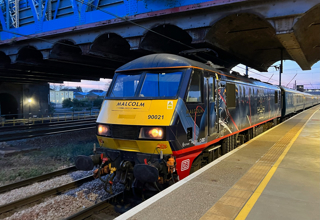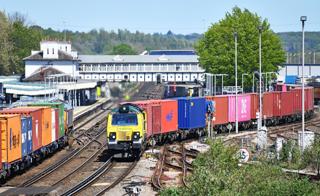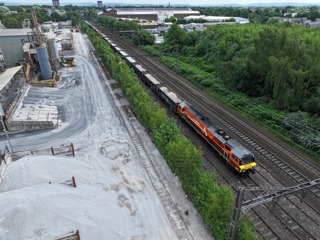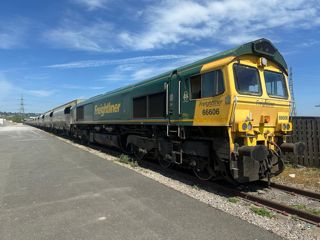With through train and ferry tickets available from most stations in Britain to Ireland and the Netherlands, Andy Comfort samples Sail Rail and wonders how many people know about this way of travelling...

With through train and ferry tickets available from most stations in Britain to Ireland and the Netherlands, Andy Comfort samples Sail Rail and wonders how many people know about this way of travelling...

As island nations, the railways of Great Britain and Ireland have always had connections with ferries.
From 1929 to 1972, the Golden Arrow train linked London with Paris, taking passengers in Pullman carriages to the old Dover Marine station, alongside the ships.
The Night Ferry train began operating in 1936. Passengers could stay on the train the whole way from London to Paris, leaving Victoria at 2300 and arriving in the Gare du Nord at 0855 the next day.
A combination of increased use of private cars, budget airlines and the opening of the Channel Tunnel changed people’s travelling habits, and consigned trains such as The Golden Arrow and the Night Ferry to the history books.
But special combined tickets mean that it’s still possible - and often relatively easy - to catch a train and ferry. At several ports around the British coast, trains pull into stations adjacent to passenger ferry terminals. And some train operating companies offer joint train and ferry travel tickets.
Greater Anglia’s Dutchflyer Rail and Sail scheme offers through tickets from any station on the GA network, including London Liverpool Street, to the port of Hook of Holland via Harwich International and the Stena ferry. The cheapest combined single adult ticket is advertised at £58.
The train pulls up into Harwich International station (formerly Harwich Parkeston Quay) and passengers walk straight into the ferry terminal.
The length of the main platform is a reminder of the boat trains which used to serve the port, to and from London, the Midlands, the North and Scotland - including ‘The European’ InterCity train to and from Edinburgh and Glasgow.
To this day, trains to and from London Liverpool Street still meet the day and night ferry crossings, and there is an hourly train along the branch line to connect with trains on the Great Eastern Main Line at Manningtree.
Transport for Wales operates Sail Rail with through tickets available from most stations in Britain to anywhere in Northern Ireland or the Republic of Ireland, travelling with Stena or Irish Ferries via Holyhead or Fishguard.
The main route to Belfast is covered by ScotRail’s Rail and Sail tickets, which allow train travel from most stations in Britain and a crossing on the Cairnryan-Belfast ferry. A coach transfer operates between Ayr railway station and the ferry terminal at Cairnryan, in south-west Scotland.
The decision to relocate ferry services from Stranraer to Cairnryan means you can no longer step off a train at the ferry port itself.
But the geography of Scotland means the rail network is well connected with ferry services, with some through tickets available to the likes of Orkney, Shetland or the Outer Hebrides.
Visiting Ireland in December 2024, I decided to use the train and ferry, rather than fly, and bought a Sail Rail ticket from a station close to me (Barnetby in North Lincolnshire) through to Dublin. I booked online via the Transport for Wales website, which told me there are two types of ticket: advance or standby.
The advance ticket is available for sale until 1800 the day before departure and requires you to make reservations on trains and the ferry. TfW advises that availability is limited, but you can book up to three months in advance.
Standby tickets are available up to and including the day of departure, but a mandatory reservation is required on the ship and tickets are only available through a booking office.
I was able to buy a standby and collect my ticket at a machine on Hull station a few days before departure, although there is a ticket machine at the unstaffed Barnetby station which would have allowed me to print it out there.
If you plan to collect standby tickets on the day of travel, then you would need to ensure that there is a booking office or ticket machine at your departure station.
My outward journey involved just two trains and the ferry. While I planned to meet friends in Belfast, I opted to spend a night in Dublin and catch the Enterprise train into Northern Ireland the next day.
A £74.70 single journey from Barnetby to Belfast (while giving me the chance for some pleasing alliteration for a headline) was complex: Barnetby to Doncaster, change for Leeds (where I would need to spend nearly five hours overnight!), the first train to Carlisle, connecting to Kilmarnock, then Ayr, and finally the bus to Cairnryan port and a 2hr 15mins crossing to Belfast.
I decided against that 20-hour journey and opted for the Holyhead option. And as my train called at Doncaster, I was able to use Donny to Dublin for my headline alliteration instead.
The first of my two trains, to take me from just 20 miles away from the North Sea right across to the Irish Sea, left Barnetby on time at 0652.
Whereas an advance ticket would have included seat reservations on the trains, my standby ticket meant I had to be prepared to take my chances of getting a seat.
I was lucky and managed to sit the whole way, although had I been with family or in a group, then we might have had to sit separately on the first leg of the journey.
Having said that, TransPennine Express provided a six-car Class 185 on my 0652 departure (the 0624 Cleethorpes-Liverpool), with plenty of unreserved seating in the rear set.
After a smooth and punctual journey to Manchester, I left the TPE train at Piccadilly at 0906 to wait for my second train - the 0944 TfW service to Holyhead.
Arriving at the remote Platform 14, where catering and toilet facilities are more limited, I used the travelator (typically, the downhill one was working, and the uphill one was not!) to reach the main concourse.
I’m not sure how often the revenue protection officer at the barrier had seen a ticket with Barnetby to Dublin on, but he waved me through with a nod.
The second train was one of TfW’s new Class 197s, the front three-car set going all the way to Holyhead, with the rear two-car set due to be uncoupled at Chester.
There were no seat reservations displayed on the screens above the windows, so I easily found a seat on the right-hand side to afford me some views along the North Wales coast.
The friendly and helpful conductor was clear in his announcements as to where the train was calling, and to the fact that it divided in Chester. A refreshment trolley passed through a couple of times during the journey of 2hrs 48mins, offering drinks and snacks, but no sandwiches.
My only disappointment (apart from the rain which prevented decent coastal views) was the conductor shortening the name of that famous Anglesey station to Llanfairpwll. But I can forgive that, as TfW delivered me safely to Holyhead station on time at 1232.
The interchange is easy, with the railway station connected to the ferry terminal. Sail Rail tickets offer you a choice of crossings on this route, using either Stena or Irish Ferries.
My ticket included a reservation on the Ulysses, the largest ship in the Irish Ferries fleet - a fact for which I was grateful, owing to the winds gusting up to gale force 8 that day.
Boarding for the 1410 crossing commenced at 1315, and I was able to check my suitcase in. With a luggage label on, the case is placed into a large van which sails on the ship across to Dublin, and delivers the cases onto a carousel inside the terminal there.
A single-decker bus took foot passengers onto the car deck of Ulysses, to where a lift and stairs were available up to the main decks. A through Sail Rail ticket guarantees you space on the ferry, and you can upgrade to a reclining seat in the lounge.
The sailing was quiet, but our departure was delayed by just over an hour owing to another ferry occupying our berth in Dublin until 1800.
Arriving in Dublin an hour behind our scheduled time of 1725, we left the ship via the gangway and escalator, passing through security and into the reception area of the terminal, where a bus was due to take foot passengers into the city centre.
Here is where things went wrong. The bus had gone to collect passengers from the Stena ferry, which was ahead of us, and had failed to return. It took a couple of phone calls from Irish Ferries staff on reception before the double-decker bus, which had clearly seen better days, pulled up outside the terminal at around 2000.
This meant I was in the centre of Dublin about two hours later than expected, but overall I found the journey to be very good value at a cost of £54.70 for the single combined ticket. One man I spoke to outside the Dublin terminal told me that he had paid more than that for just a train trip to Holyhead and had bought the ferry ticket separately because he had not heard of Sail Rail.
Three train operating companies operate the Rail and Sail schemes: Greater Anglia, ScotRail and Transport for Wales.
ScotRail said the data it holds does not give an accurate reflection on sales or route popularity, and that ticket sales might have been affected by various factors - including the temporary timetable introduced during pay negotiations with the unions, disruption caused by a fire at the former Ayr Station Hotel, and reliability issues with some CalMac ferries.
Transport for Wales told RAIL: “TfW is committed to sustainable travel, and Sail Rail is a great value alternative to flying. This year we have increased the availability of our Sail Rail products from six to eight weeks before departure, allowing our customers greater choice in their travel.
“In our last full year there were 36,317 Sail Rail journeys across the UK, with a year-on-year growth of 4%.”
Holyhead is the most popular port for passengers travelling on Sail Rail tickets, although the port was forced to close after damage to the Terminal 3 berth in two separate berthing incidents during Storm Darragh in December 2024.
This caused severe disruption, but TfW will be hoping that having the port of Holyhead fully open again will help to continue the growth in passenger numbers.
For a full version of this article with more images and data, Subscribe today and never miss an issue of RAIL. With a Print + Digital subscription, you’ll get each issue delivered to your door for FREE (UK only). Plus, enjoy an exclusive monthly e-newsletter from the Editor, rewards, discounts and prizes, AND full access to the latest and previous issues via the app.
Login to continue reading
Or register with RAIL to keep up-to-date with the latest news, insight and opinion.

















Login to comment
Comments
No comments have been made yet.